Sony VPL-PX20, VPL-PX30 User Manual

4-073-984-12(1)
PX20/PX30-VPL
LCD Data Projector
Operating Instructions |
|
GB |
||
|
|
|||
|
|
|
|
|
Mode d’emploi |
|
|
FR |
|
|
|
|
|
|
Manual de instrucciones |
|
ES |
||
|
|
|||
VPL-PX20
VPL-PX30
1999 Sony Corporation

WARNING
To prevent fire or shock hazard, do not expose the unit to rain or moisture.
To avoid electrical shock, do not open the cabinet. Refer servicing to qualified personnel only.
This symbol is intended to alert the user to the presence of uninsulated “dangerous voltage” within the product’s enclosure that may be of sufficient magnitude to constitute a risk of electric shock to persons.
This symbol is intended to alert the user to the presence of important operating and maintenance (servicing) instructions in the literature accompanying the appliance.
For the customers in the USA
This equipment has been tested and found to comply with
the limits for a Class A digital device, pursuant to Part 15 of
the FCC Rules. These limits are designed to provide
reasonable protection against harmful interference when the
equipment is operated in a commercial environment. This
equipment generates, uses, and can radiate radio frequency
energy and, if not installed and used in accordance with the
instruction manual, may cause harmful interference to radio
communications. Operation of this equipment in a
residential area is likely to cause harmful interference in
which case the user will be required to correct the
interference at his own expense.
You are cautioned that any changes or modifications not
expressly approved in this manual could void your authority
to operate this equipment.
LASER RADIATION
DO NOT STARE INTO BEAM
CLASS 2 LASER PRODUCT
RAYONNEMENT LASER
NE PAS REGARDER DANS LE FAISCEAU APPAREIL A LASER DE CLASSE 2
LASER–STRAHLING
NIGHT IN DEN STRAHL BLICKEN LASER KLASSE 2
MAX OUTPUT:1mW WAVE LENGTH:645nm
This label is located on the rear of the Remote Commander.
This label is located on the side of the Remote Commander.
CAUTION
LASER RADIATION
DO NOT STARE INTO BEAM
WAVE LENGTH:645nm
MAX OUTPUT:1mW
CLASS II LASER PRODUCT
COMPLIES WITH DHHS 21 CFR SUBCHAPTER J
SONY CORPORATION 6-7-35 KITASHINAGAWA
SHINAGAWA-KU,TOKYO,JAPAN
A
MANUFACTURED;
AVOID EXPOSURE-LASER
RADIATION IS EMITTED FROM THIS APERTURE.
This label is located on the rear of the Remote Commander.
This label is located on the rear of the Remote Commander.
Laser light shines out of this window.
Caution
use of controls or adjustments or performance of procedures other than those specified herein may result in hazardous radiation exposure.
Notes
•Do not aim the laser at people or not look into the laser transmitter.
•When the Remote Commander causes malfunction, consult with qualified Sony personnel. We change the Remote Commander as new one according to the guarantee.
2 (GB)
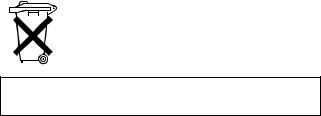
For the customers in Canada
This Class A digital apparatus complies with Canadian
ICES-003.
For the customers in the United Kingdom
WARNING
THIS APPARATUS MUST BE EARTHED
IMPORTANT
The wires in this mains lead are coloured in accordance with the following code:
Green-and-Yellow: Earth
Blue: Neutral
Brown: Live
As the colours of the wires in the mains lead of this apparatus may not correspond with the coloured markings identifying the terminals in your plug proceed as follows: The wire which is coloured green-and-yellow must be connected to the terminal in the plug which is marked by the letter E or by the safety earth symbol I or coloured green or green-and-yellow.
The wire which is coloured blue must be connected to the terminal which is marked with the letter N or coloured black. The wire which is coloured brown must be connected to the terminal which is marked with the letter L or coloured red.
Voor de klanten in Nederland
Bij dit product zijn batterijen geleverd. Wanneer deze leeg zijn, moet u ze niet weggooien maar inleveren als KCA.
The socket-outlet should be installed near the equipment and be easily accessible.
Warning on power connection
Use a proper power cord for your local power supply.
|
The United States, |
Continental |
UK, Ireland, |
Japan |
|
|
Canada |
|
Europe |
Australia, New Zealand |
|
Plug type |
VM0233 |
290B |
YP-12A |
—1) |
VM1296 |
Female end |
VM0089 |
386A |
YC-13B |
VM0310B |
VM10505 |
|
|
|
|
|
|
Cord type |
SJT |
SJT |
H05VV-F |
N13237/CO-228 |
HVCTF |
|
|
|
|
|
|
Rated Voltage & Current |
10A/125V |
10A/125V |
10A/250V |
10A/250V |
13A/125V |
|
|
|
|
|
|
Safety approval |
UL/CSA |
UL/CSA |
VDE |
VDE |
DENTORI |
.........................................................................................................................................................................................................
1) Use the correct plug for your country.
3 (GB)
4 (GB)

Table of Contents
Overview
Precautions ............................................................... |
7 (GB) |
|
Features ..................................................................... |
8 (GB) |
|
Location and Function of Controls ......................... |
9 (GB) |
|
Front/Left Side ......................................................... |
9 |
(GB) |
Rear/Right Side/Bottom ........................................... |
9 |
(GB) |
Control panel .......................................................... |
11 |
(GB) |
Connector panel ..................................................... |
12 |
(GB) |
Remote Commander .............................................. |
13 |
(GB) |
Setting up and projecting
Installing the Projector ........................................... |
14 (GB) |
Connecting .............................................................. |
15 (GB) |
Connecting with a Computer ................................. |
15 (GB) |
Connecting with a VCR/15k RGB/Component |
|
Equipment ......................................................... |
17 (GB) |
Selecting the Menu Language ............................... |
18 (GB) |
Projecting ................................................................ |
19 (GB) |
Effective tools for your presentation ..................... |
21 (GB) |
Adjustments and settings using the menu
Using the MENU ...................................................... |
22 (GB) |
The PICTURE CTRL Menu ..................................... |
22 (GB) |
The INPUT SETTING Menu .................................... |
24 (GB) |
The SET SETTING Menu ........................................ |
26 (GB) |
The INSTALL SETTING Menu ................................ |
27 (GB) |
Installation
Installation Examples ............................................. |
28 (GB) |
Floor Installation .................................................... |
28 (GB) |
Ceiling Installation ................................................. |
29 (GB) |
Tips for Installation ................................................ |
30 (GB) |
Unsuitable Installation ........................................... |
30 (GB) |
Notes on Installation .............................................. |
30 (GB) |
GB
English
5 (GB)

Maintenance
Maintenance ............................................................ |
32 (GB) |
Replacing the Lamp ............................................... |
32 (GB) |
Cleaning the Air Filter ........................................... |
33 (GB) |
Troubleshooting ..................................................... |
34 (GB) |
Other
Specifications ......................................................... |
36 (GB) |
Index ........................................................................ |
42 (GB) |
6 (GB)

Precautions
On safety
•Check that the operating voltage of your unit is identical with the voltage of your local power supply.
•Should any liquid or solid object fall into the cabinet, unplug the unit and have it checked by qualified personnel before operating it further.
•Unplug the unit from the wall outlet if it is not to be used for several days.
•To disconnect the cord, pull it out by the plug. Never pull the cord itself.
•The wall outlet should be near the unit and easily accessible.
•The unit is not disconnected to the AC power source (mains) as long as it is connected to the wall outlet, even if the unit itself has been turned off.
•Do not look into the lens while the lamp is on.
•Do not aim the laser at people or not look into the laser transmitter.
•Do not place your hand or objects near the ventilation holes — the air coming out is hot.
•Be careful not to catch your fingers by the adjuster when you lift up the projector. Do not push hard on the top of the projector with the adjuster out.
On illumination
•To obtain the best picture, the front of the screen should not be exposed to direct lighting or sunlight.
•Ceiling-mounted spot lighting is recommended. Use a cover over fluorescent lamps to avoid lowering the contrast ratio.
•Cover any windows that face the screen with opaque draperies.
•It is desirable to install the projector in a room where floor and walls are not of light-reflecting material. If the floor and walls are of reflecting material, it is recommended that the carpet and wall paper be changed to a dark color.
Precautions
On preventing internal heat build-up
After you turn off the power with the I / 1 key on the Remote Commander or on the control panel, do not disconnect the unit from the wall outlet while the cooling fan is still running.
Caution
The projector is equipped with ventilation holes (intake) on the bottom and ventilation holes (exhaust) on rear. Do not block or place anything near these holes, or internal heat build-up may occur, causing picture degradation or damage to the projector.
On cleaning
•To keep the cabinet looking new, periodically clean it with a soft cloth. Stubborn stains may be removed with a cloth lightly dampened with a mild detergent solution. Never use strong solvents, such as thinner, benzene, or abrasive cleansers, since these will damage the cabinet.
•Avoid touching the lens. To remove dust on the lens, use a soft dry cloth. Do not use a damp cloth, detergent solution, or thinner.
•Clean the filter at regular intervals every 300 hours.
On repacking
• Save the original shipping carton and packing material; they will come in handy if you ever have to ship your unit. For maximum protection, repack your unit as it was originally packed at the factory.
Overview
7 (GB)

Features
Features
High brightness, high picture quality
• High brightness
The LCD panel with microlens and the 200 W UHP lamp allow high brightness (light output 1400 ANSI lumen for VPL-PX20, and 2400 ANSI lumen for VPL-PX30) and excellent uniformity on the picture.
•High resolution
By adopting three 1.3-inch, approximately 790,000pixels XGA panels, this projector can project sharp picture with the resolutions of 1024 × 768 pixels for RGB input and 750 horizontal TV lines for video input.
•High picture performance
This projector utilizes 3D Digital Gamma correction for good picture uniformity. And the internal RGB enhancer provides sharper RGB images.
Simple setup
Easy presentation
•Remote Commander with mouse control and laser pointer functions
With the built-in mouse receiver, you can operate a computer with the Remote Commander. For presentations, you can use the laser pointer built into the Remote Commander.
•Digital ZOOM, FUNCTION and HELP keys on the Remote Commander
The Digital ZOOM allows you to enhance your presentation by zoooming in on the image. You can allocate a presentation file to the
FUNCTION keys by using the application software (CD-ROM) supplied with the projector. Just pressing the FUNCTION key opens the file immediately.
The HELP key will be helpful if you encounter a problem during operation.
•High portability
This projector is compact-7.2kg (15lb 14oz), portable size. With such a feature, a carrying handle contributes to a convenient carrying, and you can carry it everywhere you want.
•Sony original high performance APA (Auto Pixel
Alignment) function
You can get the clearest picture automatically by simply pressing the APA key when the signal is input from a computer.
•Simple setup with external equipment
This projector has 44 kinds of preset data for input signals. You can get a suitable picture by connecting an equipment with supplied cable and pressing the APA key.
•USB, Digital RGB and 5BNC connectors
USB equipment (e.g., USB mouse) allows you to expand your system. Using the application software supplied with the projector allows you to control the projector from your computer operated with Windows1) 98 operating system . The Digital RGB connector allows you to connect the projector to a Digital RGB equipment. The 5BNC input connector allows you to connect the projector to a workstation output high-resolution signals and to connect the projector to a computer from a long distance.
Multi scan compatibility
•Scan converter built-in
This projector has a built-in scan converter which converts the input signal within 1024 × 768 pixels.
•Accept various input signals
This projector accepts video signals of the composite, S video, and component as well as the 15k RGB, VGA2), SVGA2), XGA2) and SXGA2) signals, which all can be displayed.
•Compatible with six color systems
NTSC 3.58, PAL, SECAM, NTSC 4.433), PAL-M or PAL-N color system can be selected automatically or manually.
Other functions
Plug & Play
This projector complies with DDC1 and DDC2B. (DDC1 and DDC2B are the Display Data Channel (DDCTM)4) standard in the VESA standard.)
When connecting a DDC1 host system, the projector synchronizes with V.CLK that follows the VESA standard and outputs EDID (Extended Display Identification Data) to the data line.
When connecting a DDC2B host system, the projector automatically switches to the appropriate communication mode.
.........................................................................................................................................................................................................
1)Windows is a registered trademark of Microsoft Corporation (U.S.A and other countries).
2)VGA, SVGA, XGA and SXGA are registered trademarks of the International Business Machines Corporation, U.S.A.
3)NTSC4.43 is the color system used when playing back a video recorded on NTSC on an NTSC4.43 system VCR.
4)DDCTM is a registered trademark of the Video Electronics Standard Association.
8 (GB)

Location and Function of
Controls
Front/Left Side
21 qs qa 0
 9
9
3
8
4 5 7
6
Rear/Right Side/Bottom
w;
qd
qf
qg |
qh |
qj qk |
ql
Location and Function of Controls
1 Zoom ring
Adjusts the size of the picture.
2 Focus ring
Adjusts the picture focus.
3 Lens
Open the lens cap before projection.
4 Ventilation holes (exhaust)
5 Front remote control detector (SIRCS receiver)
6 Adjuster
When a picture is projected on the out of the screen, adjust the picture using this adjuster.
For details on how to use the adjusters, see “How to use the adjuster” on page 10 (GB).
7 Security lock
Connects to an optional security cable (Kensington’s).
The security lock corresponds to Kensington’s MicroSaver Security System.
If you have any comment, contact Kensington
2853 Campus Drive, San Mates, CA 94403 U.S.A.
Tel: 800-535-4242: extension 3348 Home page address: http://www.kensington.com/
8 Carrying handle
Pull up the handle from the projector for carrying.
9 Left speaker
0 Control panel
For details, see “Control panel” on page 11 (GB).
qa Right speaker
qs Lens hood
qd Rear remote control detector (SIRCS receiver)
qf AC IN socket
Connects the supplied AC power cord.
9 (GB)

Location and Function of Controls
qg Rear speaker
qh Lamp cover
qj Ventilation holes (intake)/air filter cover
Notes
•Do not place anything near the ventilation holes as it may cause internal heat build-up.
•Do not place your hand or objects near the ventilation holes — the air coming out is hot.
qk Air filter cover button
Used to remove the air filter cover.
For details, see “Cleaning the Air Filter” on page 33 (GB).
Note
Clean the air filter every 300 hours to ensure optimal performance.
ql Adjuster buttons
w; Connector panel
For details, see page 12 (GB).
How to use the adjuster
To adjust the height
Adjust the height of the projector as follows:
1 Lift the projector and press the adjuster buttons. The adjusters will extend from the projector.
Adjuster buttons
2 While pressing the buttons, lower the projector. Then, release the buttons.
For fine adjustment, turn the adjusters to the right and the left.
Notes
•Be careful not to let the projector down on your fingers.
•Do not push hard on the top of the projector with the adjusters out.
10 (GB)
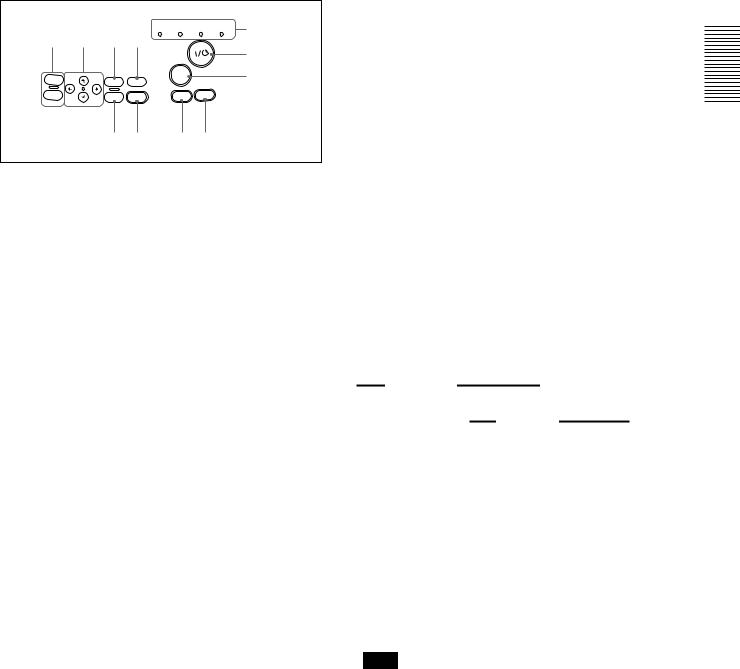
Control panel
|
|
|
LAMP/ TEMP/ |
POWER |
ON/ |
5 |
1 |
2 3 4 |
COVER FAN |
SAVING |
STANDBY |
||
|
|
|
6 |
|||
|
|
|
|
|
|
|
|
|
|
INPUT |
|
|
7 |
VOL + |
MENU |
HELP |
|
|
|
|
|
|
|
|
|||
VOL - |
ENTER |
RESET |
APA |
LIGHT |
|
|
|
|
|
|
|
||
|
qa 0 9 8 |
|
||||
1 VOL +/– keys
Adjust the volume of the built-in speakers and output level of the AUDIO jack.
+ : Increases the volume.
– :Decreases the volume.
2 Arrow keys (M/m/</,)
Used to select the menu or to make various adjustments.
3 MENU key
Displays the on-screen menu. Press again to clear the menu.
4 HELP key
If you need help information during an operation, press this key to display help messages. The Help menu lists error recoveries depending on problem type.
5 Indicators
LAMP/COVER: Lights up or flashes under the following conditions:
•Lights up when the lamp has reached the end of its life or becomes a high temperature.
•Flashes when the lamp cover or air filter cover is not secured firmly.
TEMP (Temperature)/FAN: Lights up or flashes under the following conditions:
•Lights up when temperature inside the projector becomes unusually high.
•Flashes when the fan is broken.
POWER SAVING: Lights up when the projector is in the power saving mode. When POWER SAVING in the SET SETTING menu is set to ON, the projector goes into the power saving mode if no signal is input for 10 minutes. Although the lamp goes out, the cooling fan keeps running. In the power saving mode, any key does not function for the first 40 seconds. The power saving mode is canceled when a signal is input or any key is pressed.
ON/STANDBY: Lights up or flashes under the following conditions:
• Lights in red when the AC power cord is plugged into the wall outlet. Once in the standby mode, you can turn on the projector with the I / 1 key.
Location and Function of Controls
•Lights in green when the power is turned on.
•Flashes in green while the cooling fan runs after turning off the power with the I / 1 key. The fan runs for about 120 seconds after turning off the power.
The ON/STANDBY indicator flashes quickly for the first 40 seconds.
During this time, you cannot turn the power back on with the I / 1 key.
For details on the LAMP/COVER and the TEMP/FAN indicators, see page 35 (GB).
6 I / 1 (on / standby) key
Turns on and off the projector when the projector is in the standby mode. The ON/STANDBY indicator lights in green when the power is turned on.
When turning off the power, press the I / 1 key twice following the message on the screen, or press and hold the key for about one second.
For details on steps for turning off the power, see “To turn off the power” on page 20 (GB).
7 INPUT key
Selects the input signal. Each time you press the key, the input signal switches as follows:
|
B INPUT-A |
|
|
B INPUT-B |
|
|
|
|
|
|
|
|
|||
|
|
|
|
b |
VIDEO b |
|
|
|
|
S-VIDEO |
|
||||
|
|
|
|||||
The audio signals are common to the VIDEO and S-VIDEO.
8 LIGHT key
If you press this key while the power is on, the keys on the control panel will be displayed in orange. Press this key to turn off the light.
9 APA (Auto Pixel Alignment) key
Adjusts a picture to be projected clearest automatically while a signal from the computer is input. Adjust the shift (up/down and left/right) at the same time automatically.
Note
Press the APA key when the full image is displayed on the screen. If there are black edges around the image, the APA function will not function properly and the image may extend beyond the screen.
q; RESET key
Resets the value of an item back to its factory preset value. This key functions when the menu or a setting item is displayed on the screen.
qa ENTER key
Enters the settings of items in the menu system.
11 (GB)
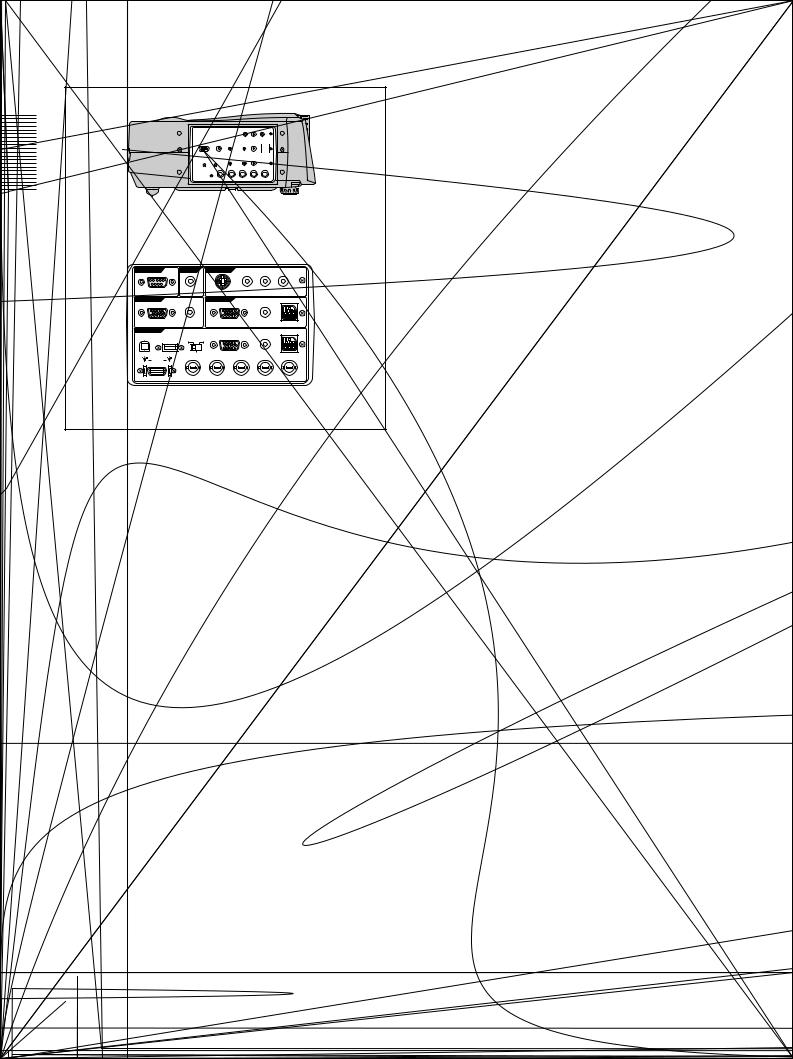
Location and Function of Controls
Connector panel
Right side
REMOTE |
CONTROL S |
VIDEO IN |
|
|
|
|
IN |
|
|
L |
R |
RS-232C |
S VIDEO |
VIDEO |
(MONO) |
|
|
PLUG IN POWER |
AUDIO |
||||
OUTPUT |
|
INPUT B |
|
|
|
MONITOR |
AUDIO |
RGB |
|
AUDIO |
MOUSE |
INPUT A |
|
|
|
|
|
|
DIGITAL |
|
|
|
|
|
RGB RGB |
|
|
|
|
|
5BNC |
RGB |
|
AUDIO |
MOUSE |
USB |
|
|
|||
|
|
|
|
|
|
DIGITAL RGB |
R/R-Y/PR |
G/Y B/B-Y/PB SYNC/HD |
VD |
||
1 INPUT A connectors
1DIGITAL RGB/5BNC/RGB switch: Selects DIGITAL RGB, 5BNC or RGB on INPUT A connectors. Select the appropriate position depending on the input signal.
DIGITAL RGB: Signal input from DIGITAL RGB connector.
5BNC: Signal input from the 5BNC connector. RGB: Signal input from the RGB connector.
2RGB input connector (HD D-sub 15-pin, female): Connects to the monitor output on a computer using the supplied cable. This connector only accepts signals from a computer.
35BNC input connectors (R/R-Y/PR, G/Y, B/B- Y/PB, SYNC/HD, VD connectors) (BNC type):
Connect to a high-resolution computer or VCR where signals are transmitted long distances; for example, when the projector has been hung from the ceiling.
According to the connected equipment, computer, component (R-Y/Y/B-Y), HDTV or DTV (DTV GBR, DTV YPBPR) signal is selected.
4DIGITAL RGB input connector (DFP 20-pin, TMDS): Connects to a digital RGB output connector on external equipment.
5USB connector: Connects your computer or USB equipment.
A plug: (Right, for downstream, 4-pin):
Connects to USB equipment.
B plug: (Left, for upstream, 4-pin): Connects to a computer. If you connect the projector and a computer, the projector automatically assumes that a USB mouse is connected; this allows you to control the mouse from the Remote Commander. The application software supplied with the projector allows you to control the
projector from your computer.
6MOUSE (13-pin) connector: Connects to the mouse port on a computer to control the mouse function using the supplied mouse cable.
7AUDIO (stereo mini-jack) jack: Connects to the audio output on a computer.
2 INPUT B connectors
Connect to external equipment such as a computer. You can control the mouse signal with the Remote Commander.
RGB input (HD D-sub 15-pin, female): Connects to the monitor output on a computer using the supplied cable. This connector only accepts signals from a computer.
AUDIO (stereo mini-jack): Connects to the audio output on a computer.
MOUSE (13-pin): Connects to the mouse port on a computer to control the mouse function using the supplied mouse cable.
3 VIDEO IN jacks
Connect to external video equipment such as a VCR.
S VIDEO (mini DIN 4-pin): Connects to the S video output (Y/C video output) on video equipment.
VIDEO (phono type): Connects to the composite video output.
AUDIO input L (MONO)/R (phono type): Connect to the audio output of equipment. For stereo equipment, use both the L and R jacks; for monaural equipment, use the L (MONO) jack only.
The audio signals are common to the VIDEO and S VIDEO.
4 CONTROL S IN/PLUG IN POWER (DC 5V output) jack
Connects to the control S out jacks of the Sony equipment. Connects to the CONTROL S OUT jack on the supplied Remote Commander when using it as a wired Remote Commander. In this case, you do not need to install the batteries in the Remote Commander, since the power is supplied from this jack.
5 RS-232C connector (D-sub 9-pin, female)
Connects to a computer to operate the projector from the computer.
12 (GB)

Location and Function of Controls
6 OUTPUT connectors
MONITOR (HD D-sub 15-pin, female): Connects to the video input connector on the monitor. Outputs signals from the selected channel in the INPUT A (RGB or 5BNC) or INPUT B (RGB) connector. This connector does not output any signals from the DIGITAL RGB connector.
AUDIO (phono type): Connects to external active speakers.
The volume of the speakers can be controlled by the VOLUME +/– keys on the Remote Commander or the VOL +/– keys on the control panel.
6 Joy stick
Functions as a mouse of a computer connected to the unit.
7 Arrow keys (M/m/</,)
8 L CLICK key
Functions as a left button on a mouse. When connected to a Macintosh1) computer, the L CLICK key functions as a mouse button.
9 R CLICK key
Functions as a right button on a mouse. When connected to a Macintosh computer, the R CLICK key functions as a mouse button.
Remote Commander
The keys which have the same names as on the control panel function identically.
You can control a connected computer using the Remote Commander.
For details, see “Connecting with a Computer” on page 15 (GB).
wa ws
w; |
COMMAND |
/ |
|
||
ql |
1 |
||||
OFF |
ON |
|
|||
qk |
HELP |
APA |
INPUT |
2 |
|
|
|||||
MUTING |
|
3 |
|||
qj |
|
||||
AUDIO |
PIC |
+ |
4 |
||
qh |
FUNCTION |
VOLUME |
|||
1 |
2 |
– |
|
||
qg |
MENU |
|
LASER |
5 |
|
|
|
|
|||
|
|
|
|
6 |
|
|
ENTER |
|
R CLICK |
7 8 |
|
qf
 9
9
RESET D ZOOM
qd +
+
–0
qa,qs
Notes on laser beam
•Do not look into the laser transmitter.
•Do not aim the laser at people.
1 I / 1 key
2 INPUT key
3 APA (Auto Pixel Alignment) key
4 VOLUME +/– keys
5 LASER key
Emits laser beam from the laser transmitter when you press this key.
0 D ZOOM +/– key
Enlarges the image at a desired location on the screen. +: Pressing the + key once displays the icon. This
icon indicates the point you want to enlarge. Use an arrow key (M/m/</,) to move the icon to the point to be enlarged. Press the + key repeatedly until the image is enlarged to your requirements.
–:Pressing the – key reduces an image that has been enlarged with the D ZOOM + key.
qa Strap holder
Attaches the supplied strap.
qs CONTROL S OUT jack (stereo minijack)
Connects to the CONTROL S IN jack on the projector with the connecting cable (not supplied) when using the Remote Commander as a wired one. In this case, you do not need to install the batteries since the power is supplied via the CONTROL S IN jack on the projector.
qd RESET key
qf ENTER key
qg MENU key
qh FUNCTION 1/2 keys
When you connect the projector with a computer, you can open a file on the screen by just pressing the FUNCTION key. This will enhance your presentation. To use this function, allocate a file to the FUNCTION key by using the application software. For details on how to allocate a file to the FUNCTION key, refer to the help file of the application software.
.........................................................................................................................................................................................................
1) Macintosh is a registered trademark of Apple Computer, Inc.
13 (GB)

Location and Function of Controls / Installing the Projector
Be sure to install the battery from the # side.
14 (GB)

15 (GB)

Connecting
When connecting with a Macintosh computer
Right side
 Signal adapter (not supplied)
Signal adapter (not supplied)
to monitor out
SIC-S20
Mouse cable (not supplied)
to audio out
to mouse port
16 (GB)

Using USB equipment (e.g., USB mouse)
Connect the USB equipment to the USB connector on the connector panel.
You can connect your computer to the projector via the RGB connector, 5BNC connector or DIGITAL RGB connector. (The example below uses the RGB connector.)
DIGITAL
RGB RGB
Right side
5BNC
REMOTE |
CONTROL S |
VIDEO IN |
|
|
|
|
IN |
|
|
L |
R |
RS-232C |
S VIDEO |
VIDEO |
(MONO) |
|
|
PLUG IN POWER |
AUDIO |
||||
OUTPUT |
|
INPUT B |
|
|
|
MONITOR |
AUDIO |
RGB |
|
AUDIO |
MOUSE |
INPUT A |
|
|
|
|
|
|
DIGITAL |
|
|
|
|
|
RGB RGB |
|
|
|
|
|
5BNC |
RGB |
|
AUDIO |
MOUSE |
USB |
|
|
|||
|
|
|
|
|
|
DIGITAL RGB |
R/R-Y/PR |
G/Y B/B-Y/PB SYNC/HD |
VD |
||
|
|
Stereo audio |
USB |
|
connecting |
|
cable (not |
|
cable A |
|
|
|
supplied) |
|
type-B |
|
|
|
|
|
type |
|
HD D-sub |
(sup- |
|
|
|
15-pin |
|
plied) |
|
|
|
cable |
|
Other USB |
|
|
|
(supplied) |
|
equipment |
|
|
|
|
|
to USB |
to |
to audio |
port |
monitor |
out |
|
out |
|
Computer
Note
Set the DIGITAL RGB/5BNC/RGB switch to the suitable position depending on the connection.
Notes
•Your computer may not start correctly when it has been connected to the USB connector on the projector via the USB cable. In this case, first disconnect the USB cable, restart the computer, then connect the computer to the projector using the USB cable supplied with the projector.
•The USB connector on this projector will function only with a computer operated with Windows 98.
•When you connect the mouse to your computer via the USB connector, do not connect another mouse to the MOUSE port. The projector automatically assumes that a USB mouse is connected.
Connecting
USB hub function
If you connect the projector and your computer using the USB cable for the first time, the following devices will be recognized.
1General purpose USB hub
2USB human interface device (for wireless mouse function)
3USB human interface device (for projector control function)
Any other devices connected to the downstream connector of a projector are recognized by your computer.
Connecting with a VCR/15k RGB/ Component Equipment
This section describes how to connect the projector with a VCR, external active speakers, and 15k RGB/ component equipment.
Also refer to the instruction manuals of the equipment to be connected.
When making connections, be sure to:
•turn off all equipment before making any connections.
•use the proper cables for each connection.
•insert the plugs of the cables properly; plugs that are not fully inserted often generate noise. When pulling out a cable, be sure to pull it out from the plug, not
the cable itself.
Right side
S-Video cable |
Audio/video |
(not supplied) |
cable |
|
(supplied) |
to S video |
to audio/video |
output |
outputs |
Active speakers |
VCR |
17 (GB)

18 (GB)

Projecting
ON/STANDBY indicator
|
|
INPUT |
|
MENU |
HELP |
|
|
ENTER |
RESET |
APA |
LIGHT |
|
|
Rear remote control detector
1 After all equipment is connected completely, plug the AC power cord into the wall outlet.
The ON/STANDBY indicator lights in red and the projector goes into the standby mode.
2 Press the I / 1 key.
The ON/STANDBY indicator lights in green.
3 Turn on equipment connected to the projector. Press the INPUT key to select the input source.
INPUT-A: Selects audio and video signals input from the INPUT A connector.
Projecting
INPUT-B: Selects audio and video signals input from the INPUT B connector.
VIDEO: Selects audio and video signals input from the AUDIO/VIDEO (VIDEO IN) jacks.
S-VIDEO: Selects audio and video signals input from the AUDIO/S VIDEO (VIDEO IN) jacks.
Note
The AUDIO (VIDEO IN) jacks are used as audio outputs of both VIDEO and S-VIDEO.
4 Turn the zoom ring to adjust the size of the picture.
5 Turn the focus ring to adjust the focus.
Note
Looking into the lens when projecting may cause injury to your eyes.
To |
Press |
Adjust the volume the VOL +/– keys on the control panel or the VOLUME +/– keys on the Remoter Commander.
Cut off the sound the AUDIO MUTING key on the Remote Commander. To restore the sound, press the AUDIO MUTING key again or press the VOL + key on the control panel or the VOLUME + key on the Remote Commander.
Cut off the picture the PIC MUTING key on the Remote Commander. To restore the picture, press the PIC MUTING key again.
To get the clearest picture
You can get the suitable picture when a signal from the computer is input. Press the APA key.
The picture is automatically adjusted to be projected clearest.
Notes
•Adjust the signal when the still picture is displayed on the screen.
•Press the APA key when the full image is displayed on the screen. If there are black edges around the image, the APA function will not function properly and the image may extend beyond the screen.
•If you switch the input signal or re-connect a computer, press the APA key again to get the suitable picture.
19 (GB)
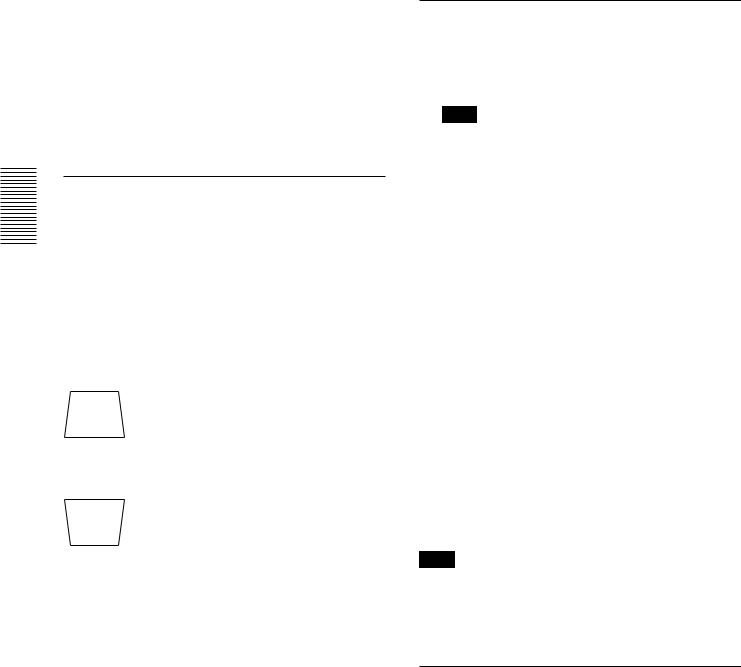
Projecting
•“ADJUSTING” appears on the screen. Press the APA key again during the adjustment to restore the original screen.
•“Complete!” appears on the screen when the picture is adjusted properly. The picture may not be adjusted properly depending on the kinds of input signals.
•Adjust the items in the INPUT SETTING menu when you adjust the picture manually.
For details, see page 24 (GB).
To correct the trapezoid
When the projecting image is a trapezoid, change the projector’s position/height by moving the adjuster.
For details on “How to use the adjuster”, see page 10 (GB).
If the image is still a trapezoid, correct it in DIGIT KEYSTONE in the INSTALL SETTING menu.
When the base edge is longer than the upper edge as shown in the figure below:
Set the value to negative.
When the upper edge is longer than the base edge as shown in the figure below:
Set the value to positive.
For details on “DIGIT KEYSTONE”, see page 27 (GB).
To turn off the power
1 Press the I / 1 key.
“Power OFF?” appears on the screen.
Note
The message will disappear if you press any key except the I / 1 key, or if you do not press any key for five seconds.
2 Press the I / 1 key.
The ON/STANDBY indicator flashes in green and the fan continues to run for about 120 seconds to reduce the internal heat. Also, the ON/STANDBY indicator flashes quickly for the first 40 seconds. During this time, you will not be able to turn the power back on with the I / 1 key.
3 Unplug the AC power cord from the wall outlet after the fan stops running and the ON/STANDBY indicator lights in red.
When you cannot confirm the on-screen message
When you cannot confirm the on-screen message in a certain condition, you can turn off the power by holding the I / 1 key for about one second.
Note
Do not unplug the AC power cord while the fan is still running; otherwise, the fan will stop although the internal heat is still high, leading to breakdown of the projector.
About the air filter cleaning
Clean the air filter every 300 hours to ensure optimal performance.
20 (GB)

Projecting
Effective tools for your presentation
To enlarge the image (Digital Zoom function)
You can select a point in the image to enlarge.
1 Press the D ZOOM + key on the Remote Commander.
The Digital Zoom icon appears at the center of the image.
Digital Zoom icon
2 Move the icon to the point on the image you want to enlarge. Use the arrow keys (M/m/</,) to move the icon.
3 Press the D ZOOM + key again.
The image where the icon is located is enlarged. By pressing the + key repeatedly, the image size increases. (ratio of enlargement: max. 4 times)
Use the arrow keys(M/m/</,) to scroll the enlarged image.
To return the image back to its original size
Press the D ZOOM – key on the Remote Commander.
To use the Laser Pointer function
Press the LASER key on the Remote Commander. The laser pointer appears. The pointer is helpful in indicating a particular point on the screen.
21 (GB)

Using the MENU / The PICTURE CTRL Menu
Using the MENU
The projector is equipped with an on-screen menu for making various adjustments and settings.
To select the language used in the menu, see page 26 (GB).
1 Press the MENU key.
The menu display appears.
The bar on the icon of the currently selected menu is highlighted in yellow.
PICTURE CTRL |
INPUT-A |
CONTRAST: 80
BRIGHT: 50
RGB ENHANCER: 30
GAMMA MODE: GRAPHICS
COLOR TEMP: LOW
2 Use the M or m key to select a menu, then press the , or ENTER key.
The selected menu appears.
Menus |
Setting items |
|
SET SETTING |
INPUT-A |
|
|
||
|
STATUS: |
ON |
|
INPUT-A: |
COMPUTER |
|
AUTO INPUT SEL: OFF |
|
|
LANGUAGE: |
ENGLISH |
|
SPEAKER: |
ON |
|
POWER SAVING: |
OFF |
|
SIRCS RECEIVER: |
FRONT&REAR |
3 Make setting or adjustment on an item.
For details on setting individual items, see the relevant menu pages.
To clear the menu display
Press the MENU key.
The menu display disappears automatically if no key is pressed for one minute.
To reset items that have been adjusted
Press the RESET key.
“Complete!” appears on the screen and the settings appearing on the screen will be reset to their factory preset values.
Items which can be reset are:
•“CONTRAST”, “BRIGHT”, “COLOR”, “HUE”, “SHARP” and “RGB ENHANCER” in the PICTURE CTRL menu.
•“DOT PHASE”, “SIZE H” and “SHIFT” in the INPUT SETTING menu.
About the memory of the settings
The settings are automatically stored in the projector memory.
When no signal is input
When there is no input signal, “NO INPUT–Cannot adjust this item.” appears on the screen, and each item cannot be adjusted.
The PICTURE CTRL Menu
The PICTURE CTRL (control) menu is used for adjusting the picture.
Unadjustable items depending on the input signal are not displayed in the menu.
When the video signal is input
PICTURE CTRL |
VIDEO |
CONTRAST: |
80 |
BRIGHT: |
50 |
COLOR: |
50 |
HUE: |
50 |
SHARP: |
50 |
D.PICTURE: |
ON |
COLOR TEMP: LOW |
|
COLOR SYS: AUTO |
|
When the RGB signal is input
PICTURE CTRL |
INPUT-A |
|
|
CONTRAST: |
80 |
BRIGHT: |
50 |
RGB ENHANCER: 30 |
|
GAMMA MODE: GRAPHICS |
|
COLOR TEMP: LOW |
|
Operation
1. Select an item
Use the M or m key to select the item, then press the
,or ENTER key.
2.Adjust an item
• When changing the adjustment level:
To increase the number, press the M or , key.
22 (GB)

To decrease the number, press the m or < key. Press the ENTER key to restore the original screen.
• When changing the setting:
Press the M or m key to change the setting.
Press the ENTER or < key to restore the original screen.
CONTRAST
Adjusts the picture contrast.
The higher the setting, the greater the contrast. The lower the setting, the lower the contrast.
BRIGHT
Adjusts the picture brightness.
The higher the setting, the brighter the picture. The lower the setting, the darker the picture.
COLOR
Adjusts color intensity.
The higher the setting, the greater the intensity. The lower the setting, the lower the intensity.
HUE
Adjusts color tones.
The higher the setting, the picture becomes greenish. The lower the setting, the picture becomes purplish.
SHARP
Adjusts the picture sharpness.
The higher the setting, the sharper the picture. The lower the setting, the softer the picture.
RGB ENHANCER
Adjusts the picture sharpness when the RGB signals are input.
The higher the setting, the sharper the picture. The lower the setting, the softer the picture.
D. (Dynamic) PICTURE
Emphasizes the black color.
ON: Emphasizes the black color to produce a bolder “dynamic” picture.
OFF: Reproduces the dark portions of the picture accurately, in accordance with the source signal.
GAMMA MODE
Selects a gamma correction curve.
GRAPHICS: Improves the reproduction of half tones. Photos can be reproduced in natural tones.
TEXT: Contrasts black and white. Suitable for images that contain lots of text.
COLOR TEMP
Adjusts the color temperature.
HIGH: Makes the white color bluish.
LOW: Makes the white color reddish.
COLOR SYS (System)
Selects the color system of the input signal.
AUTO: Automatically selects one of the following signals: NTSC 3.58, PAL, SECAM, NTSC4.43.
PAL-M/N: Automatically selects one of the following signals: PAL-M/PAL-N, NTSC3.58.
Normally, set to AUTO.
If the picture is distorted or colorless, select the color system according to the input signal.
Input signals and adjustable/setting items
Item |
|
Input signal |
||
|
Video or |
CompoHDTV |
RGB |
|
|
|
|
|
|
|
|
|
|
|
23 (GB)
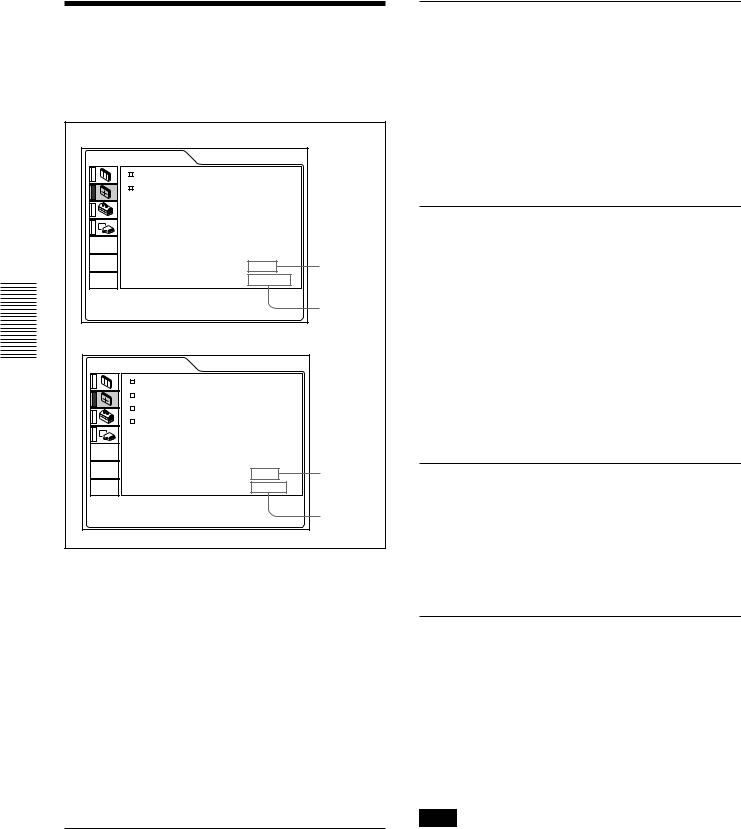
The INPUT SETTING Menu
The INPUT SETTING Menu
The INPUT SETTING menu is used to adjust the input signal.
Unadjustable items depending on the input signal are not displayed in the menu.
When the video signal is input
INPUT SETTING |
|
VIDEO |
|
|
|
ASPECT: |
16:9 |
|
SHIFT |
H: 200 |
V: 30 |
|
|
NO.01 |
|
|
VIDEO/60 |
When the RGB signal is input
INPUT SETTING |
|
INPUT-A |
|
|
|
DOT PHASE: |
0 |
|
SIZE H: |
1056 |
|
SHIFT |
H: 200 |
V: 30 |
SCAN CONV: |
ON |
|
Memory No.
Signal type
NO.17 |
Memory No. |
800x600 |
|
|
Signal type |
Operation
1. Select an item
Use the M or m key to select the item, then press the , or ENTER key.
2. Adjust an item
• When changing the adjustment level:
To increase the number, press the M or , key. To decrease the number, press the m or < key.
Press the ENTER key to restore the original screen.
• When changing the setting:
Press the M or m key to change the setting.
Press the ENTER or < key to restore the original screen.
DOT PHASE
Adjusts the dot phase of the LCD panel and the signal input from the INPUT A/B connector. Adjust the picture further for finer picture after the picture is adjusted with pressing the APA key.
Adjust the picture to where it looks clearest.
SIZE H
Adjusts the horizontal size of picture input from the INPUT A/B connector.
The higher the setting, the larger the horizontal size of the picture.
The lower the setting, the smaller the horizontal size of the picture. Adjust the setting according to the dots of the input signal. For details on the suitable value for the preset signals, see page 25 (GB).
SHIFT
Adjusts the position of the picture input from the INPUT A/B connectors or VIDEO IN jacks.
H adjusts the horizontal position of the picture. V adjusts the vertical position of the picture.
As the setting for H increases, the picture moves to the right, and as the setting decreases, the picture moves to the left.
As the setting for V increases, the picture moves up, and as the setting decreases, the picture moves down. Use the < or the , key to adjust the horizontal position and the M and m key for the vertical position.
ASPECT
Sets the aspect ratio of the picture.
When inputting 16:9 (squeezed) signal from equipment such as a DVD player, set to 16:9.
4:3 : When the picture with ratio 4:3 is input.
16:9 : When the picture with ratio 16:9 (squeezed) is input.
SCAN CONV (Scan converter)
Converts the signal to display the picture according to the screen size.
ON: Displays the picture according to the screen size. The picture will lose some clarity.
OFF: Displays the picture while matching one pixel of input picture element to that of the LCD. The picture will be clear but the picture size will be smaller.
Note
When the XGA or SXGA signal is input, this item will not be displayed.
24 (GB)

The INPUT SETTING Menu
Input signals and adjustable/setting items
Item |
|
Input signal |
|
|
|
Video or |
15k RGB/ |
HDTV |
RGB1) B&W |
|
S video (Y/C) |
Component |
|
|
DOT |
– |
– |
|
– |
PHASE |
|
|
|
|
SIZE H |
– |
– |
|
– |
SHIFT |
|
|
|
|
ASPECT |
|
|
– |
– |
SCAN |
– |
– |
– |
– |
CONV |
|
|
|
(lower |
|
|
|
|
than |
|
|
|
|
SVGA |
|
|
|
|
only) |
 : Adjustable/can be set
: Adjustable/can be set
– : Not adjustable/can not be set
About the preset memory No.
This projector has 44 kinds of preset data for input signals (the preset memory). The memory number of the current input signal and the signal type are displayed when the preset signal is input. This projector automatically detects the signal type. When the signal is registered to the preset memory, a suitable picture is displayed on the screen according to the signal type. You can adjust the picture through the INPUT SETTING menu.
This projector also has 20 kinds of user memories for each INPUT-A/B. When an unpreset signal is input for the first time, memory number is displayed as 0. If the input signal is adjusted in the INPUT SETTING menu, the setting via INPUT-A/B is stored. When more than 20 user memories are registered for each INPUT-A/B, the newest memory is automatically stored over the oldest one.
Preset signals
|
Memory |
Preset signal |
fH |
fV |
Sync |
SIZE |
|
||
|
No. |
|
|
|
(kHz) |
(Hz) |
|
H |
|
|
1 |
|
Video 60 Hz |
15.734 |
59.940 |
H-neg V-neg |
|
|
|
|
2 |
|
Video 50 Hz |
15.625 |
50.000 |
H-neg V-neg |
|
|
|
|
3 |
|
15k RGB/Component 60 Hz |
15.734 |
59.940 |
S on G/Y |
|
|
|
|
4 |
|
15k RGB/Component 50 Hz |
15.625 |
50.000 |
or |
|
|
|
|
5 |
|
HDTV |
|
33.750 |
60.000 |
Composite sync |
|
|
|
6 |
|
640 × 350 |
VGA mode 1 |
31.469 |
70.086 |
H-pos V-neg |
800 |
|
|
7 |
|
|
VGA VESA2) 85 Hz |
37.861 |
85.080 |
H-pos V-neg |
832 |
|
|
8 |
|
640 × 400 |
PC-98013) Normal |
24.823 |
56.416 |
H-neg V-neg |
848 |
|
|
9 |
|
|
VGA mode 2 |
31.469 |
70.086 |
H-neg V-pos |
800 |
|
|
10 |
|
|
VGA VESA 85 Hz |
37.861 |
85.080 |
H-neg V-pos |
832 |
|
|
|
|
|
||||||
|
11 |
|
640 × 480 |
VGA mode 3 |
31.469 |
59.940 |
H-neg V-neg |
800 |
|
|
12 |
|
|
Macintosh 13” |
35.000 |
66.667 |
H-neg V-neg |
864 |
|
|
|
|
|
|
|
|
|
|
|
|
13 |
|
|
VGA VESA 72 Hz |
37.861 |
72.809 |
H-neg V-neg |
832 |
|
|
14 |
|
|
VGA VESA 75 Hz |
37.500 |
75.000 |
H-neg V-neg |
840 |
|
|
15 |
|
|
VGA VESA 85 Hz |
43.269 |
85.008 |
H-neg V-neg |
832 |
|
|
|
|
|
||||||
|
16 |
|
800 × 600 |
SVGA VESA 56 Hz |
35.156 |
56.250 |
H-pos V-pos |
1024 |
|
|
17 |
|
|
SVGA VESA 60 Hz |
37.879 |
60.317 |
H-pos V-pos |
1056 |
|
|
18 |
|
|
SVGA VESA 72 Hz |
48.077 |
72.188 |
H-pos V-pos |
1040 |
|
|
19 |
|
|
SVGA VESA 75 Hz |
46.875 |
75.000 |
H-pos V-pos |
1056 |
|
|
20 |
|
|
SVGA VESA 85 Hz |
53.674 |
85.061 |
H-pos V-pos |
1048 |
|
|
|
|
|
||||||
|
21 |
|
832 × 624 |
Macintosh 16” |
49.724 |
74.550 |
H-neg V-neg |
1152 |
|
|
22 |
|
1024 × 768 |
XGA VESA 43 Hz |
35.524 |
43.479 |
H-pos V-pos |
1264 |
|
|
23 |
|
|
XGA VESA 60 Hz |
48.363 |
60.004 |
H-neg V-neg |
1344 |
|
|
24 |
|
|
XGA VESA 70 Hz |
56.476 |
69.955 |
H-neg V-neg |
1328 |
|
|
25 |
|
|
XGA VESA 75 Hz |
60.023 |
75.029 |
H-pos V-pos |
1312 |
|
|
26 |
|
|
XGA VESA 85 Hz |
68.677 |
84.997 |
H-pos V-pos |
1376 |
|
|
|
|
|
|
|
|
|
|
|
|
27 |
|
1152 × 864 |
SXGA VESA 70 Hz |
63.995 |
70.016 |
H-pos V-pos |
1472 |
|
|
28 |
|
|
SXGA VESA 75 Hz |
67.500 |
75.000 |
H-pos V-pos |
1600 |
|
|
29 |
|
|
SXGA VESA 85 Hz |
77.487 |
85.057 |
H-pos V-pos |
1568 |
|
|
|
|
|
||||||
|
30 |
|
1152 × 900 |
Sunmicro LO |
61.795 |
65.960 |
H-neg V-neg |
1504 |
|
|
31 |
|
|
Sunmicro HI |
71.713 |
76.047 |
Composite sync |
1472 |
|
|
|
|
|
||||||
|
32 |
|
1280 × 960 |
SXGA VESA 60 Hz |
60.000 |
60.000 |
H-pos V-pos |
1800 |
|
|
33 |
|
|
SXGA VESA 75 Hz |
75.000 |
75.000 |
H-pos V-pos |
1728 |
|
|
|
|
|
||||||
|
34 |
|
1280 × 1024 |
SXGA VESA 43 Hz |
46.433 |
43.436 |
H-pos V-pos |
1696 |
|
|
35 |
|
|
SGI-5 |
53.316 |
50.062 |
S on G |
1680 |
|
|
36 |
|
|
SXGA VESA 60 Hz |
63.974 |
60.013 |
H-pos V-pos |
1696 |
|
|
37 |
|
|
SXGA VESA 75 Hz |
79.976 |
75.025 |
H-pos V-pos |
1688 |
|
|
38 |
|
|
SXGA VESA 85 Hz |
91.146 |
85.024 |
H-pos V-pos |
1728 |
|
|
|
|
|
||||||
|
|
|
|
|
|
|
|
|
|
|
43 |
|
PC Component |
480/60P (NTSCDouble frequency) |
|
|
|
|
|
|
|
|
480/60P |
31.470 |
60.000 |
S on G |
|
|
|
|
44 |
|
575/50P |
575/50P (PALDouble frequency) |
31.250 |
50.000 |
S on G |
|
|
|
45 |
|
1080/50I |
1080/50I |
28.130 |
50.000 |
|
|
|
|
46 |
|
1080& |
1080/50I-2 |
31.250 |
50.000 |
|
|
|
|
|
|
1152/60 |
|
|
|
|
|
|
|
47 |
|
720/60P |
720/60P |
45.000 |
60.000 |
|
|
|
|
48 |
|
720/50P |
720/50P |
37.500 |
50.000 |
|
|
|
.........................................................................................................................................................................................................
1)The RGB signals of a computer
2)VESA is a registered trademark of Video Electronics Standard Association.
3)PC-98 is a registered trademark of NEC Corporation.
25 (GB)
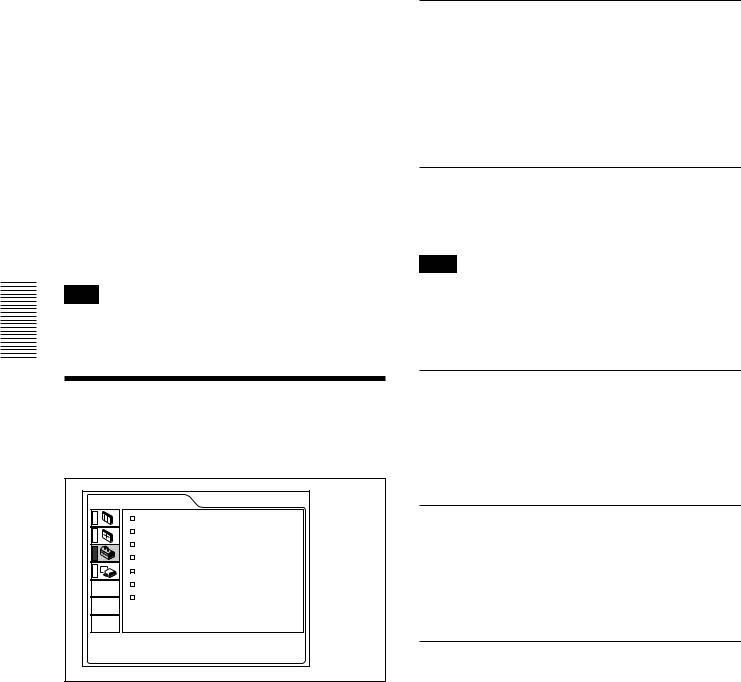
The INPUT SETTING Menu / The SET SETTING Menu
Since the data is recalled from the preset memory about the following signals, you can use these preset data by adjusting SIZE H. Make fine adjustment by adjusting SHIFT.
Signal |
Memory No. |
SIZE H |
Super Mac-2 |
23 |
1312 |
|
|
|
SGI-1 |
23 |
1320 |
|
|
|
Macintosh 19” |
25 |
1328 |
|
|
|
Macintosh 21” |
28 |
1456 |
|
|
|
Sony News |
36 |
1708 |
|
|
|
PC-9821 |
36 |
1600 |
1280 × 1024 |
|
|
WS Sunmicro |
37 |
1664 |
|
|
|
Note
When the aspect ratio of input signal is other than 4:3, a part of the screen is displayed in black.
The SET SETTING Menu
The SET SETTING menu is used for changing the settings of the projector.
SET SETTING |
INPUT-A |
|
|
STATUS: |
ON |
INPUT-A: |
COMPUTER |
AUTO INPUT SEL: OFF |
|
LANGUAGE: |
ENGLISH |
SPEAKER: |
ON |
POWER SAVING: |
OFF |
SIRCS RECEIVER: |
FRONT&REAR |
Operation
1. Select an item
Use the M or m key to select the item, then press the , or ENTER key.
2. Change the setting
Press the M or m key to change the setting.
To restore the original screen, press the ENTER or < key.
STATUS (on-screen display)
Sets up the on-screen display.
ON: Shows all of the on-screen displays.
OFF: Turns off the on-screen displays except for the menus, a message when turning off the power, and warning messages.
For details on the warning messages, see page 35 (GB).
INPUT-A
Selects the computer, component, DTV YPBPR or DTV GBR signal input from the 5BNC connector.
Note
If the setting is not correct, “Please check INPUT-A setting.” appears on the screen and the color of the picture becomes strange or the picture is not displayed.
AUTO INPUT SEL
When set to ON, the projector detects input signals in the following order: INPUT-A/INPUT-B/VIDEO/S- VIDEO. It indicates the input channel when the power is turned on or the INPUT key is pressed.
LANGUAGE
Selects the language used in the menu and on-screen displays.
Available languages are: English, French, German, Italian, Spanish, Japanese and Chinese.
SPEAKER
Set to OFF to cut off the sound of the internal speakers. When set to OFF, “SPEAKER OFF” appears on the screen when you turn on the power.
26 (GB)
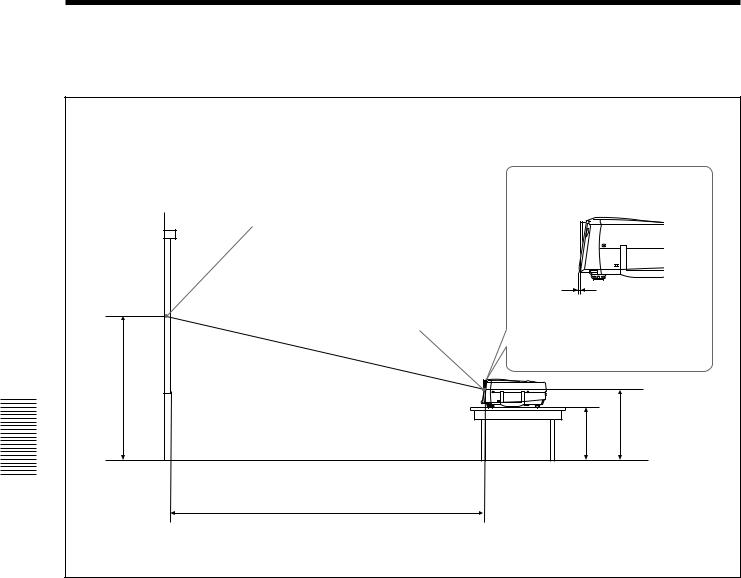
Installation Examples
Installation Examples
Floor Installation
|
a: Distance between the screen and the center of the lens |
|
|
b: Distance from the floor to the center of the lens |
|
|
c: Distance from the floor to the foot of the projector |
|
|
x: Free |
|
|
|
Distance from the front of |
Wall |
|
the cabinet and the center |
|
of the lens |
|
|
Center of the screen |
|
|
|
|
|
Center of the lens |
Standard lens: 10 mm (13/32 inches) |
|
|
|
x |
|
|
|
|
b |
|
|
c |
|
|
Floor |
|
a |
|
Unit: mm (inches)
Screen size (inches) |
40 |
60 |
80 |
100 |
120 |
150 |
180 |
200 |
250 |
300 |
||
|
|
|
|
|
|
|
|
|
|
|
|
|
|
Minimum |
1490 |
2280 |
3060 |
3850 |
4630 |
5810 |
6990 |
7770 |
9740 |
11700 |
|
|
(58 3/4) |
(89 7/8) |
(120 1/2) |
(151 5/8) |
(182 3/8) |
(228 7/8) |
(275 1/4) |
(306) |
(383 5/8) |
(460 3/4) |
||
a |
|
|||||||||||
|
|
|
|
|
|
|
|
|
|
|
||
Maximum |
1820 |
2780 |
3740 |
4700 |
5660 |
7100 |
8540 |
9500 |
11900 |
14300 |
||
|
||||||||||||
|
(71 3/4) |
(109 1/2) |
(147 3/8) |
(185 1/8) |
(222 7/8) |
(279 5/8) |
(336 3/8) |
(374 1/8) |
(468 5/8) |
(563 1/8) |
||
|
|
|||||||||||
|
|
|
|
|
|
|
|
|
|
|
|
|
b |
x–305 |
x–457 |
x–610 |
x–762 |
x–914 |
x–1143 |
x–1372 |
x–1524 |
x–1905 |
x–2286 |
||
(12) |
(18) |
(24) |
(30) |
(36) |
(45) |
(54) |
(60) |
(75 1/8) |
(90 1/8) |
|||
|
|
|||||||||||
|
|
|
|
|
|
|
|
|
|
|
|
|
c |
x–394 |
x–546 |
x–699 |
x–851 |
x–1003 |
x–1232 |
x–1461 |
x–1613 |
x–1994 |
x–2375 |
||
(15 5/8) |
(21 5/8) |
(27 5/8) |
(33 5/8) |
(39 5/8) |
(48 5/8) |
(57 5/8) |
(63 5/8) |
(78 5/8) |
(93 5/8) |
|||
|
|
|||||||||||
|
|
|
|
|
|
|
|
|
|
|
|
|
To calculate the installation measurement (unit: mm)
SS: screen size diagonal (inches)
a (minimum) = {(SS × 50.18/1.3102) – 75.10104}× 1.025
a (maximum) = {(SS × 64.518746/1.3102) – 107.8977}× 0.975 b = x – (SS/1.3102× 9.984)
c = x – (SS/1.3102× 9.984 + 89)
28 (GB)

|
Installation Examples |
Ceiling Installation |
|
When installing the projector on the ceiling, use the |
For ceiling installation, consult with qualified Sony |
PSS-610 Projector Suspension Support. |
personnel. |
a:Distance between the screen and the center of the lens
b:Distance between the ceiling and the center of the lens
x: Distance between the ceiling and the center of the screen |
PSS-610 Projector Suspension Support |
|
(not supplied) |
||
|
||
a |
|
|
|
Ceiling |
|
|
b |
|
Center of the screen |
|
x
Distance from the front of Center of the lens the cabinet and the center
of the lens
Standard lens:
10 mm (13/32 inches)
Wall
Unit: mm (inches)
Screen size (inches) |
80 |
100 |
120 |
150 |
180 |
200 |
250 |
300 |
||
|
|
|
|
|
|
|
|
|
|
|
|
Minimum |
3060 |
3850 |
4630 |
5810 |
6990 |
7770 |
9740 |
11700 |
|
|
(120 1/2) |
(151 5/8) |
(182 3/8) |
(228 7/8) |
(275 1/4) |
(306) |
(383 5/8) |
(460 3/4) |
||
a |
|
|||||||||
|
|
|
|
|
|
|
|
|
||
Maximum |
3740 |
4700 |
5660 |
7100 |
8540 |
9500 |
11900 |
14300 |
||
|
||||||||||
|
(147 3/8) |
(185 1/8) |
(222 7/8) |
(279 5/8) |
(336 3/8) |
(374 1/8) |
(468 5/8) |
(563 1/8) |
||
|
|
|||||||||
|
|
|
|
|
|
|
|
|
|
|
x |
b+610 |
b+762 |
b+914 |
b+1143 |
b+1372 |
b+1524 |
b+1905 |
b+2286 |
||
(24) |
(30) |
(36) |
(45) |
(54) |
(60) |
(75 1/8) |
(90 1/8) |
|||
|
|
|
||||||||
b |
231/256/281/331/356/381 mm (9 1/8/10 1/8/11 1/8/13 1/8/14 1/8/15 inches) adjustable when using PSS-610 |
|||||||||
|
|
|
|
|
|
|
|
|
|
|
To calculate the installation measurement (unit: mm)
SS: screen size diagonal (inches)
a (minimum) = {(SS × 50.18/1.3102) – 75.10104}× 1.025
a (maximum) = {(SS × 64.518746/1.3102) – 107.8977}× 0.975 x = b + (SS/1.3102 × 9.984)
Installation
29 (GB)
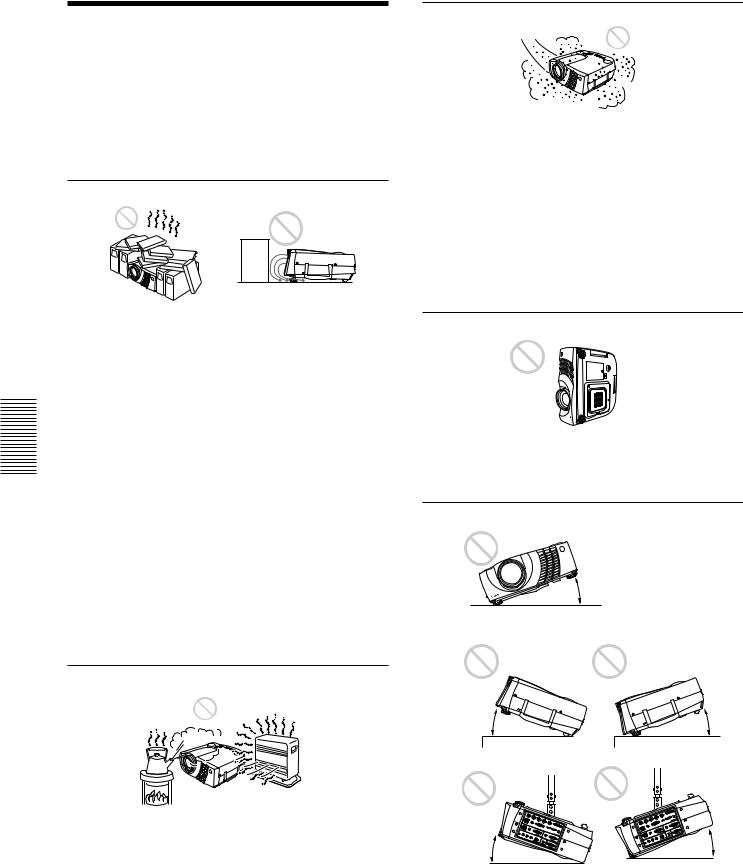
Tips for Installation
Tips for Installation
Unsuitable Installation
Do not install the projector in the following situations. These installations may cause malfunction or damage to the projector.
Poorly ventilated
Very dusty
Avoid installing the unit in a location where there is a lot of dust; otherwise, the air filter will be obstructed. The dust blocking the air through the filter may cause raising the internal heat of the projector. Clean it up periodically.
•Allow adequate air circulation to prevent internal heat build-up. Do not place the unit on surfaces (rugs, blankets, etc.) or near materials (curtains, draperies) that may block the ventilation holes. When the internal heat builds up due to the block-up, the temperature sensor will function with the message “High temp.! Lamp off in 1 min.” The power will be turned off automatically after one minute.
•Leave space of more than 30 cm (11 7/8 inches) around the unit.
•Be careful that the ventilation holes may inhale tininess such as a piece of paper.
•If you put something in front of the front ventilation holes, the exhaust may be inhaled into the projector through the ventilation holes at the bottom, causing the internal temperature to rise, which activates the protection circuit. Install the projector so that the exhaust is not blocked.
Highly heated and humid
•Avoid installing the unit in a location where the temperature or humidity is very high, or temperature is very low.
•To avoid moisture condensation, do not install the unit in a location where the temperature may rise rapidly.
Notes on Installation
Carry out the followings.
No toppling of the unit
Avoid using as the unit topples over on its side. It may cause malfunction.
Use to be level
20°
20° |
20° |
20° |
20° |
|
Avoid using as the unit tilts more than 20 degrees. Do not install the unit other than on the floor or ceiling. These installation may cause malfunction.
30 (GB)
